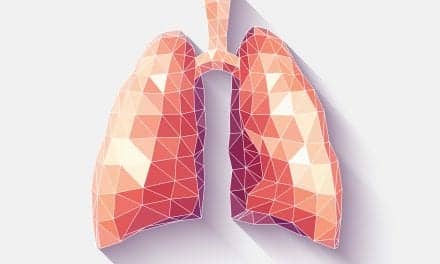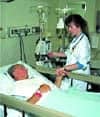The pathogenesis of pulmonary hypertension is becoming better understood through identifying genes associated with the disease, and future research is necessary to focus on developing therapeutic interventions to improve patients’ outcomes.
Elevation of pulmonary arterial pressure, without an obvious etiology, is the primary characteristic of the disease referred to as primary pulmonary hypertension (PPH).1 The most widely used criteria that are currently referenced to make a diagnosis of PPH were developed by the National Institutes of Health Registry on PPH.2 These criteria are:
1. Demonstration of a mean pulmonary artery pressure greater than 25 mm Hg at rest or 30 mm Hg with exercise.
2. Absence of significant parenchymal lung disease, chronic thromboembolic disease, left-sided valvular or myocardial disease, congenital heart disease, or systemic connective tissue disease.
The abnormally elevated pulmonary artery pressure that is associated with this rare disorder is related to changes in the small blood vessels within the lungs. This results in an increased resistance to blood flow through the vessels. The strain that is placed on the right ventricle in an effort to move adequate amounts of blood through the lungs is significant.3
Although the true incidence of PPH is unknown, it is estimated that approximately one to two people per million develop the disease. The first reported case of PPH dates back to 1891, although the illness did not receive its current name until 1951.3 PPH appears to predominantly affect women, and usually progresses to death as a result of right ventricular failure within a few years following diagnosis.
More recently, the use of appetite suppressants such as fenfluramine and dexfenfluramine was associated with an increased risk of developing PPH. This resulted in significant media coverage as more and more cases of PPH secondary to the use of these appetite suppressants were suspected and reported. In addition to this association with PPH, there is also evidence to support a familial link.1
Treatment
In the past several years, new pharmacologic agents have emerged, which appear to have the potential to provide positive therapeutic applications for the treatment of PPH. Given the prognosis of untreated PPH, research in the use of these agents is an area of increasing interest.
The most significant development in the treatment of this disorder has involved the use of intravenous prostacyclin (prostaglandin I2, PGI2) and prostacyclin analogues. The infusion of prostacyclin has been shown in clinical trials to improve exercise tolerance and pulmonary hemodynamics.4
Vasoconstriction is a prominent feature of PPH, believed to be due to an impairment in the production of the vasodilators prostacyclin and nitric oxide in the pulmonary vascular endothelium. This provides a possible rationale for the use of vasodilators to treat this disorder. Nitric oxide, epoprostenol (prostacyclin), and adenosine are short-acting, potent, and titratable vasodilators that may be used to evaluate an acute response to therapy.1 Intravenous epoprostenol or adenosine generally produces similar pulmonary vasodilatory effects as inhaled nitric oxide.5 It should be noted that the continuous infusion of epoprostenol through a central venous catheter is costly, averaging in the vicinity of $60,000 per year. The high cost, combined with its undesirable side effects, points to the need for additional therapy options.
Inhaled nitric oxide, a selective pulmonary vasodilator, may demonstrate beneficial effects in diseases characterized by pulmonary hypertension and hypoxemia, including persistent pulmonary hypertension of the newborn, PPH, and acute respiratory distress syndrome. The cost of nitric oxide administration is currently in the range of up to $3,000 per day. A new administration model may cap the fee at a total of $4,000 per patient. It should be noted, however, that evidence regarding the effectiveness of inhaled nitric oxide in the treatment of pulmonary hypertension in the adult population is lacking in terms of improving mortality. Some studies have demonstrated an improvement in gas exchange, with no change in patient outcome.6
In some clinical conditions such as lung fibrosis with accompanying pulmonary hypertension, the administration of systemic vasodilators may lead to troubling side effects. Severe systemic hypotension, in the absence of adequate cardiac output, and worsening of ventilation/perfusion mismatching and shunting have been shown to occur in some patient populations.7,8
There has been some investigation into the use of oral prostacyclin, but this has been limited because of poor bioavailability. Several small clinical studies have examined stable prostacyclin analogues, such as beraprost. Administered orally, beraprost was found to acutely reduce pulmonary artery pressure (PAP).8,9 In a more recent study, beraprost was observed to result in an increased exercise tolerance, evaluated using the 6-minute walk test.10
Calcium-channel blockers such as nifedipine and diltiazem are popular for long-term therapy, although significantly larger doses than those typically used for treating systemic hypertension and coronary artery disease may be necessary. An alternative calcium-channel blocker, amlodipine, has more selective vasodilator properties and has been used on patients who cannot tolerate the side effects produced by other agents. Table 1 shows the most commonly used vasodilators for treating PPH.
The oral and intravenous administration of sildenafil, a cyclic-guanosine-monophosphate phosphodiesterase inhibitor, has been examined and shown to enhance and prolong the vasodilatory effects of inhaled nitric oxide.11,12 A study comparing the effects of inhaled iloprost to oral sildenafil in pulmonary hypertension found that iloprost caused a greater reduction in pulmonary artery pressure, while the effects of sildenafil, having a smaller effect on pulmonary artery pressure, produced a much longer duration of action. The combined effects of inhaled iloprost, which is a prostacyclin analogue, with oral sildenafil resulted in a further reduction in PAP and an increase in cardiac output without affecting the heart rate or systemic blood pressure significantly.13 Another inhaled drug that has shown potential is the use of aerosolized epoprostenol.
Inhaled epoprostenol has demonstrated the ability to produce selective pulmonary vasodilatory effects that are similar to those of inhaled nitric oxide, without the unpopular side effects experienced with systemic delivery of the drug.1 Future studies confirming this benefit are warranted.
Current medical treatment for PPH includes anticoagulation, with warfarin considered the drug of choice; calcium channel blockers; and continuous intravenous or aerosolized prostacyclin analogues.15 Although these treatments may improve survival rates, lung or heart-lung transplantation may provide the most definitive treatment of the disease. Other therapy that is currently under investigation includes the use of phosphodiesterase inhibitors and endothelin receptor antagonists.16 In a recent study of 32 patients with PPH, patients receiving the endothelin receptor antagonist, bosentan were compared to those receiving placebo drugs. The results demonstrated an increased exercise capacity and improved blood circulation for those receiving bosentan. Pulmonary vascular resistance, a primary characteristic of pulmonary hypertension, was also significantly reduced in the bosentan patients. In addition, the average pulmonary artery pressure, pulmonary capillary wedge pressure, and right-atrial pressure were all reduced in the bosentan group.17
With the identification of the genes associated with cases of PPH, the pathogenesis of this fatal disease is becoming better understood. Future research is necessary to focus on the development of therapeutic interventions to improve the outcome of those with PPH. The challenge for future research activities is to identify an effective, technically feasible, and less costly method of treating individuals with pulmonary hypertension.
Paul Nuccio, RRT, is clinical educator for respiratory care, and Paulette Downs, RRT, is a staff respiratory therapist, at Brigham and Women’s Hospital, Boston.
References
1. Rubin LJ. Primary pulmonary hypertension. N Engl J Med. 1997;336:111.
2. Rich S, Dantzker DR, Ayers SM, et al. Primary pulmonary hypertension: a national prospective study. Ann Intern Med. 1987;107:216.
3. Facts About Primary Pulmonary Hypertension. Bethesda, Md: National Heart, Lung, and Blood Institute; 1996.
4. Barst RJ, Rubin LJ, Long WA, et al. A comparison of continuous intravenous epoprostenol (prostacyclin) with conventional therapy for primary pulmonary hypertension. N Engl J Med. 1996;334:296-301.
5. Sitbon O, Brenot F, Denjean A, et al. Inhaled nitric oxide as a screening vasodilator agent in primary pulmonary hypertension: a dose-response study and comparison with prostacyclin. Am J Respir Crit Care Med. 1995;151:384-389.
6. Troncy E, Collet JP, Shapiro S, et al. Inhaled nitric oxide in acute respiratory distress syndrome. Am J Respir Crit Care Med. 1998;157:1483-1488.
7. Olschewski H, Ghofrani HA, Walmrath D, et al. Inhaled prostacyclin and iloprost in severe pulmonary hypertension secondary to lung fibrosis. Am J Respir Crit Care Med. 1999;160:600-607.
8. Augusti AGN, Rodriguez-Robin R. Effect of pulmonary hypertension on gas exchange. Eur Respir J. 1993;6:1371-1377.
9. Saji T, Ozawa Y, Ishikita T, et al. Short-term hemodynamic effect of a new oral PGI2 analogue, beraprost, in primary and secondary pulmonary hypertension. Am J Cardiol. 1996;78:244-247.
10. Nagaya N, Uematsu M, Okano Y, et al. Effect of orally active prostacyclin analogue on survival of outpatients with primary pulmonary hypertension. J Am Coll Cardiol. 1999;34:1188-1192.
11. Zhao L, Mason NA, Morrell NW, et al. Sildenafil inhibits hypoxia-induced pulmonary hypertension. Circulation. 2001;104:424.
12. Shekerdemian LS, Ravn HB, Penny DJ. Intravenous sildenafil lowers pulmonary vascular resistance in a model of neonatal pulmonary hypertension. Am J Respir Crit Care Med. 2002;165:1098-1102.
13. Wilkens H, Guth A, Konig J, et al. Effect of inhaled iloprost plus oral sildenafil in patients with primary pulmonary hypertension. Circulation. 2001;104:1218-1222.
14. Van Heerden PV, Barden A, Michalopoulos N, et al. Dose-response to inhaled aerosolized prostacyclin for hypoxemia due to ARDS. Chest. 2000;117:819-827.
15. Gaine SP, Rubin LJ. Primary pulmonary hypertension. Lancet. 1998;352:719-725.
16. Newman JH, Lane KB. Hypertensive pulmonary vascular disease. Am J Respir Crit Care Med. 2000;162:2020-2021.
17. Channick RN, Simonneau G, Sitbon O, et al. Effects of the dual endothelin-receptor antagonist bosentan in patients with pulmonary hypertension: a randomised placebo-controlled study. Lancet. 2001;358:1119-1123.









